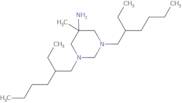Informazioni sul prodotto
- 1,3-Bis(2-ethylhexyl)-5-methylhexahydropyrimidin-5-amine
- 1,3-Bis(2-ethylhexyl)hexahydro-5-methyl-5-pyrimidinamine
- 1,3-Bis(b-ethylhexyl)-5-methyl-5-aminohexahydropyrimidine
- 141-94-6
- 5-Amino-1,3-bis(2-ethylhexyl)-5-methylhexahydropyrimidine
- 5-Amino-1,3-bis(2-ethylhexyl)hexahydro-5-methylpyrimidine
- 5-Amino-1,3-bis(β-ethylhexyl)-5-methylhexahydropyrimidine
- 5-Amino-1,3-di(β-ethylhexyl)hexahydro-5-methylpyrimidine
- 5-Pyrimidinamine, 1,3-Bis(2-Ethylhexyl)Hexahydro-5-Methyl-
- Elsix
- Vedi altri sinonimi
- Glypesin
- Hexigel
- Hexocil
- Hexopyrimidine
- Hexoral
- Hextril
- NSC 17764
- Oraldene
- Pyrimidine, 5-amino-1,3-bis(2-ethylhexyl)hexahydro-5-methyl-
- Steri/Sol
- Sterilate
- Sterisil
- Triocil
- Triscol
Hexetidine is a cationic surfactant that has been used as a preservative in mouthwash and toothpaste. It has also been shown to inhibit the growth of influenza virus in vitro. Hexetidine is active against bacteria, fungi, and viruses. Hexetidine inhibits the replication of Escherichia coli, Staphylococcus aureus, Streptococcus pneumoniae, Candida albicans, and other microorganisms. Hexetidine was found to be most effective when combined with benzalkonium chloride (BZK), an antimicrobial agent that kills bacteria by interfering with the cell membrane. This combination showed an antibacterial efficacy statistically superior to either hexetidine or BZK alone.





